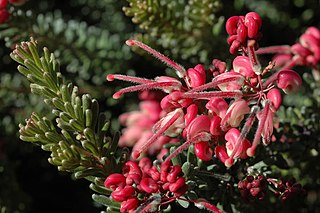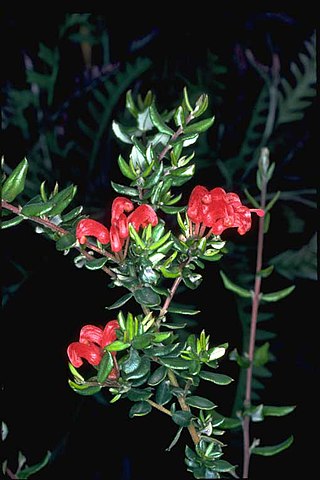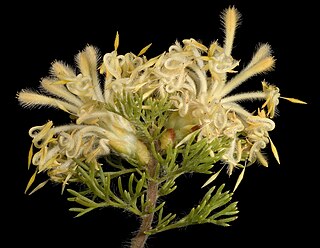
Hakea laurina is shrub or small tree commonly known as kodjet or pin-cushion hakea and is endemic to Western Australia. The Noongar name for the plant is kodjet or kojet. It has red and cream conspicuous globular flowers and lance shaped leaves.

Grevillea lanigera, commonly known as woolly grevillea, is a species of flowering plant in the family Proteaceae and is endemic to south-eastern continental Australia. It is a spreading shrub with narrowly oblong to more or less linear leaves and clusters of pink to red, and cream-coloured flowers.

Grevillea bipinnatifida, commonly known as fuchsia grevillea, is a species of flowering plant in the family Proteaceae and is endemic to the south-west of Western Australia. It is a spreading shrub, usually with bipinnatifid leaves and loose clusters of dull pink to crimson flowers.

Grevillea crithmifolia is a species of flowering plant in the family Proteaceae and is endemic to the south-west of Western Australia. It is a dense shrub with linear leaves, divided leaves with narrowly oblong lobes, or both, and clusters of pale pink to creamy-white flowers.

Grevillea caleyi, also known as Caley's grevillea, is a species of flowering plant in the family Proteaceae and is endemic to a restricted area of New South Wales. It is an open, spreading shrub with deeply divided leaves with linear lobes, and fawn flowers with a maroon to red style.

Grevillea ilicifolia, commonly known as holly grevillea or holly bush, is a species of flowering plant in the family Proteaceae and is endemic to southern continental Australia. It is a spreading to prostrate shrub with holly-like leaves with sharply-pointed triangular to egg-shaped teeth or lobes, and clusters of green to cream-coloured and mauve flowers with a pink to red style.

Isopogon trilobus, commonly known as barrel coneflower, is a species of flowering plant in the family Proteaceae and is endemic to South Coast Western Australia. It is a shrub with wedge-shaped leaves with lobed or toothed leaves, and oval, spherical or barrel-shaped heads of cream-coloured to yellow flowers.
Grevillea obtusiflora is a species of flowering plant in the family Proteaceae and is endemic to a small area of eastern New South Wales. It is a low, spreading to erect shrub with many stems, narrowly elliptic to oblong or linear to narrowly egg-shaped leaves with the narrower end towards the base, and pinkish-red and cream-coloured flowers with a red style.

Grevillea quercifolia, commonly known as the oak-leaf grevillea, is a species of flowering plant in the protea family and is endemic to the southwest of Western Australia. It is a straggly to sprawling shrub usually with pinnatifid or serrated leaves, and oval to cylindrical clusters of pale to deep pink flowers.

Grevillea triternata is species of flowering plant in the family Proteaceae and is endemic to New South Wales. It is a dense, compact shrub with divided leaves, the end lobes sharply pointed, linear to narrowly triangular, and cylindrical clusters of white flowers with a cream-coloured to pale yellow style.
Grevillea divaricata is a species of flowering plant in the family Proteaceae and is endemic to central New South Wales. It is a low shrub with linear leaves and small clusters of flowers on the ends of branchlets. It is only known from the type specimen.

Isopogon divergens, commonly known as spreading coneflower, is a species of plant in the family Proteaceae and is endemic to the south-west of Western Australia. It is a shrub with pinnate leaves and more or less spherical heads of glabrous pink flowers followed by an oval to cylindrical fruiting cone.

Grevillea depauperata is a species of flowering plant in the family Proteaceae and is endemic to the south-west of Western Australia. It is a low, dense, spreading shrub with oblong or egg-shaped leaves and clusters of red to orange flowers.

Grevillea fasciculata is a species of flowering plant in the family Proteaceae and is endemic to the south-west of Western Australia. It is a low, often spreading shrub with narrowly elliptic to more or less linear leaves and erect clusters of red and orange or orange and yellow flowers.

Grevillea anethifolia, commonly known as spiny cream spider flower, is a species of flowering plant in the family Proteaceae and is endemic to continental Australia. It is an erect shrub with hairy branchlets, lobed leaves, the lobes sharply pointed, and white to pale yellow or cream-coloured flowers.

Grevillea baxteri, commonly known as the Cape Arid grevillea, is a flowering plant of the family Proteaceae and is endemic to the south-west of Western Australia. It is an erect to spreading shrub with pinnatipartite leaves and greenish to fawn or creamy-orange flowers.

Grevillea pyramidalis, commonly known as the caustic bush, is a species of flowering plant in the family Proteaceae and is endemic to north-western Australia. It is an erect, spindly shrub or small tree with simple linear or pinnatisect leaves with linear to narrowly egg-shaped lobes, and white to yellow or cream-coloured flowers.

Petrophile media is a species of flowering plant in the family Proteaceae and is endemic to southwestern Western Australia. It is a low, spreading to erect shrub with needle-shaped leaves, and oval heads of hairy cream-coloured to yellow flowers.

Petrophile serruriae is a species of flowering plant in the family Proteaceae and is endemic to southwestern Western Australia. It is a shrub with crowded, pinnate, needle-shaped, sharply-pointed leaves, and oval heads of silky-hairy yellow, greyish mauve to pink flowers.

Grevillea angulata is a species of flowering plant in the family Proteaceae and is endemic to the Top End of the Northern Territory. It is a spreading to erect shrub with pinnatifid or toothed leaves and cream-coloured flowers.


















